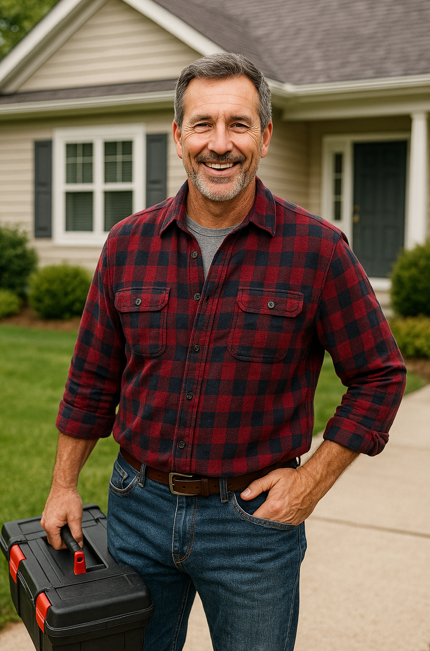👋 Let’s Talk About R-32 and Safety
Hey folks, Mike Sanders here.
If you’ve been looking into upgrading your AC, you’ve probably run across the term R-32 refrigerant. It’s in a ton of modern, energy-efficient systems—and for good reason. But I also know what’s on your mind:
“Wait… isn’t R-32 flammable?”
Let’s talk safety. Because if you’re going to install something in your home, especially something as critical as an air conditioner, you deserve clear, honest info on how it works and what the real risks are.
Spoiler: R-32 is safe for residential use, and it's being used worldwide in millions of homes. But let’s break it down.
🔬 What Is R-32, Anyway?
R-32 (difluoromethane) is a next-gen refrigerant with a Global Warming Potential (GWP) of 675. That’s 67% lower than R-410A, which it’s replacing across the HVAC industry.
It also:
-
Is more energy efficient
-
Requires less refrigerant charge
-
Has zero ozone depletion potential
📘 Learn more from the EPA’s Refrigerant Safety Page.
🧯 The A2L Safety Classification Explained
R-32 is classified as an A2L refrigerant by ASHRAE.
-
“A” = Low toxicity
-
“2L” = Mildly flammable with low burning velocity
It’s not explosive. It doesn’t ignite easily. And in normal operation, it’s sealed inside the system—you’ll never interact with it directly.
🛑 In fact, R-32 needs a very specific air/fuel ratio and ignition source to combust—something you just don’t find in real-world HVAC setups.
Check out ASHRAE’s A2L Refrigerant Safety Guide for technical details.
🌍 Global Use: R-32 Is Everywhere
You may be surprised to learn that over 160 million R-32 units have already been installed globally—in places like:
-
Europe (since 2013)
-
Australia
-
Japan
-
South Korea
-
United States (ramping up since 2023)
And guess what? There have been no documented cases of residential fires caused by R-32. It’s tried, tested, and trusted.
🏠 R-32 Safety Features Built Into Today’s Systems
Modern air conditioners that use R-32 are designed with safety in mind:
-
Leak detection protocols
-
Proper ventilation standards
-
Lower refrigerant charge requirements
-
UL-certified components
HVAC techs are trained to handle R-32 safely. Installers follow UL 60335-2-40 safety standards for residential HVAC systems.
In fact, the newer systems often use less refrigerant overall, which reduces environmental and safety impact.
🧠 Common Misconceptions
Let’s bust a few myths:
❌ “R-32 is explosive.”
Nope. It’s classified as non-explosive under normal conditions. The ignition point is high and the velocity is low. You’d need very specific lab-like conditions to get it to burn.
❌ “If it leaks, my house is at risk.”
Actually, small refrigerant leaks in a ventilated space won’t reach concentrations high enough to ignite—plus, systems are built with sensors and shutoff switches.
❌ “You can’t fix it yourself.”
Well, I wouldn’t suggest you mess with any refrigerant. But that’s true for R-410A too. Leave those repairs to the pros.
🛠️ What Homeowners Should Do
You can feel confident using R-32 in your home. But just like with any HVAC system, follow best practices:
-
Hire licensed technicians
-
Keep outdoor units clear and secure
-
Schedule routine maintenance (check refrigerant levels annually)
-
Don’t puncture, cut, or tamper with lines
Want to be proactive? Learn from certified pros using the ACCA’s safety checklist.
✅ Why I Recommend R-32 to My Clients
Here’s why I’ve been pointing folks to R-32 systems:
-
They’re efficient: Higher SEER2 with less energy waste
-
They’re sustainable: Lower GWP helps future-proof your home
-
They’re safe: Modern systems are designed with full compliance to the latest safety codes
It’s not just safe—it’s smart.
Looking for a high-efficiency, R-32-based air conditioner? Check out our full R-32 3-Ton Residential Guide.
🔚 Final Thoughts from Mike
R-32 may sound like some kind of science experiment—but it’s not. It’s a safe, proven, and efficient refrigerant that’s powering the next generation of air conditioners.
So if you're thinking about upgrading your AC system, don’t let the A2L label scare you off. R-32 systems are designed with safety in mind, installed by trained pros, and used by millions worldwide.
As always, if you’ve got questions—I’ve got answers. Let’s keep your home cool, efficient, and safe.
🧰Stay smart, stay comfortable, and I’ll catch you next time! - Mike🧰







